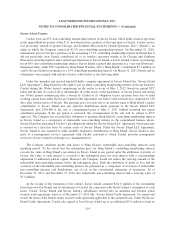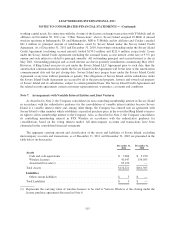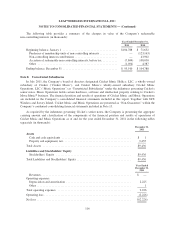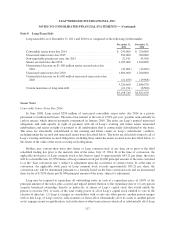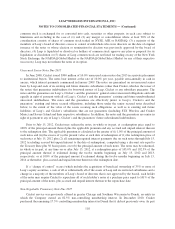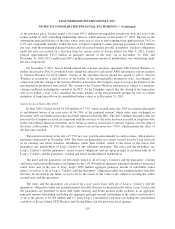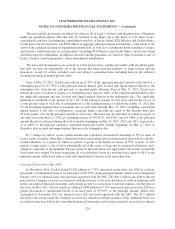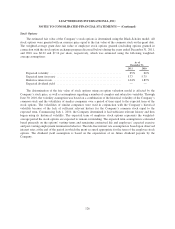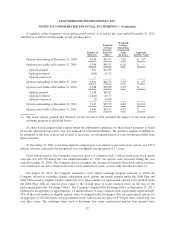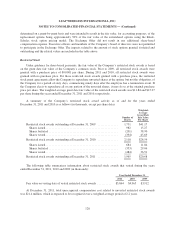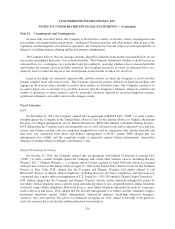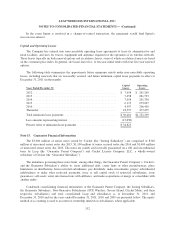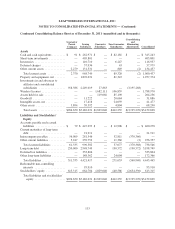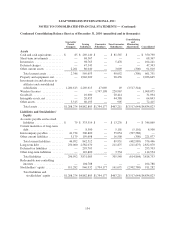Cricket Wireless 2011 Annual Report Download - page 134
Download and view the complete annual report
Please find page 134 of the 2011 Cricket Wireless annual report below. You can navigate through the pages in the report by either clicking on the pages listed below, or by using the keyword search tool below to find specific information within the annual report.
LEAP WIRELESS INTERNATIONAL, INC.
NOTES TO CONSOLIDATED FINANCIAL STATEMENTS — (Continued)
Deferred tax assets (liabilities) are reflected in the accompanying consolidated balance sheets as follows (in
thousands):
As of December 31,
2011 2010
Current deferred tax assets (included in other current assets) ............ $ 7,816 $ 7,751
Long-term deferred tax liabilities .................................. (333,804) (295,703)
$(325,988) $(287,952)
Except with respect to the $1.9 million TMT credit outstanding as of December 31, 2011 and 2010, the
Company established a full valuation allowance against its net deferred tax assets due to the uncertainty
surrounding the realization of such assets. The valuation allowance is based on available evidence, including the
Company’s historical operating losses. Deferred tax liabilities associated with wireless licenses and investments
in certain joint ventures cannot be considered a source of taxable income to support the realization of deferred tax
assets because these deferred tax liabilities will not reverse until some indefinite future period. Since it has
recorded a valuation allowance against the majority of its deferred tax assets, the Company carries a net deferred
tax liability on its balance sheet. During the year ended December 31, 2011, the Company recorded a $138.9
million increase to its valuation allowance, which primarily consisted of $125.5 million and $13.2 million related
to the impact of 2011 federal and state taxable losses, respectively. During the year ended December 31, 2010,
the Company recorded a $176.7 million increase to its valuation allowance, which primarily consisted of $152.2
million and $13.3 million related to the impact of 2010 federal and state taxable losses, respectively.
At December 31, 2011, the Company estimated it had federal and state NOL carryforwards of
approximately $2.5 billion (which begin to expire in 2022 for federal income tax purposes and of which $37.2
million will expire at the end of 2012 for state income tax purposes). In addition, the Company had federal
capital loss carryforwards of approximately $8.0 million (which begin to expire in 2013). Included in the
Company’s federal and state net operating loss carryforwards are $23.5 million of losses which, when utilized,
will increase additional paid-in capital by approximately $9.0 million.
The Company’s ability to utilize NOLs could be limited if it were to experience an “ownership change,” as
defined in Section 382 of the Internal Revenue Code and similar state provisions. In general terms, an ownership
change can occur whenever there is a cumulative shift in the ownership of a company by more than
50 percentage points by one or more “5% stockholders” within a three-year period. The occurrence of such a
change in the Company’s ownership would limit the amount of NOL carryforwards it could utilize in a given
year. This limitation would accelerate cash tax payments the Company would be required to make and likely
result in a substantial portion of its NOLs expiring before the Company could fully utilize them.
In 2011, trading in Leap common stock increased the risk of an ownership change under Section 382 of the
Internal Revenue Code. Accordingly, on August 30, 2011, the Company’s board of directors adopted a Tax
Benefit Preservation Plan to help deter acquisitions of Leap common stock that could result in an ownership
change under Section 382 and thus help preserve the Company’s ability to use its NOL carryforwards. The Tax
Benefit Preservation Plan is designed to deter acquisitions of Leap common stock that would result in a
stockholder owning 4.99% or more of Leap common stock (as calculated under Section 382), or any existing
holder of 4.99% or more of Leap common stock acquiring additional shares, by substantially diluting the
ownership interest of any such stockholder unless the stockholder obtains an exemption from the Company’s
board of directors.
None of the Company’s NOL carryforwards are being considered as an uncertain tax position or disclosed
as an unrecognized tax benefit. Any carryforwards that expire prior to utilization as a result of a Section 382
124


